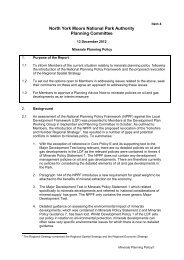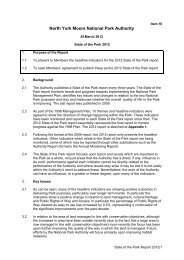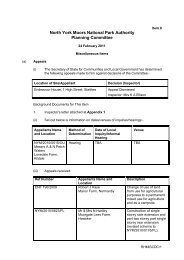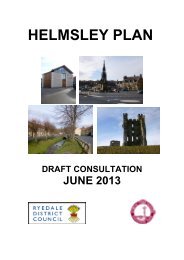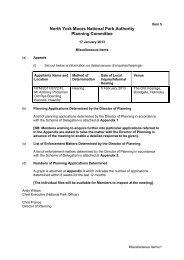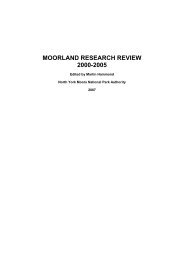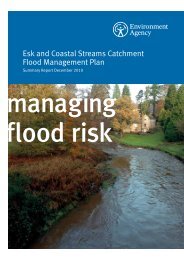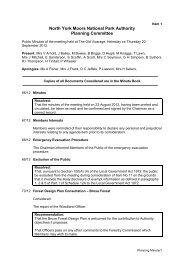Management Plan - North York Moors National Park
Management Plan - North York Moors National Park
Management Plan - North York Moors National Park
Create successful ePaper yourself
Turn your PDF publications into a flip-book with our unique Google optimized e-Paper software.
Business and Land <strong>Management</strong>4.2 AgricultureFarming in the <strong>National</strong> <strong>Park</strong> produces food for widerpopulations, has a key role in the local economy and is integralto many rural communities. Unusually for an upland <strong>National</strong><strong>Park</strong>, all farming sectors are represented with some 20% offarmland in the <strong>National</strong> <strong>Park</strong> being arable. Farming has greatlyinfluenced the landscape of the <strong>North</strong> <strong>York</strong> <strong>Moors</strong> and alsosupports important habitats and wildlife, and helps to sustaintourism.A report carried out by Askham Bryan College 60 on behalf ofthe <strong>National</strong> <strong>Park</strong> Authority estimated the output, in quantityand value, for each farming sector in the <strong>National</strong> <strong>Park</strong>.Throughout this section the figures for output are based on thecalculations in this report and are subject to the assumptionsthat were made in it. Output values are all net of subsidies andother income and are based on 2009 agricultural census data.From 1990 to 2009 stock numbers declined by; 38% dairyherd, 23% breeding sheep flock and 43% pig breeding herd.The suckler beef herd rose by 14% and ‘other pigs’ by 29%(equating to around 95% of total pigs). It would appear basedon historic data that stock numbers could change significantly ifthere were the political and economic drivers to facilitate it.The total value of output from agriculture in 2009 wascalculated at £56m. Of this the largest proportion was dairy(24%) followed by cropping (23%). Further benefits to the localeconomy are provided by the employment of 2,554 people inagriculture, less than half of which are employed on a full timebasis. The number of people employed in farming has fallensignificantly over the last 20 years with the largest decline beingin full time workers.The farming sector relies heavily on payments provided via theCommon Agricultural Policy, which at the time of writing iscurrently under review. These take two forms, direct paymentsfrom the Single Payment Scheme and agri-environmentpayments made in return for committing to varying levels ofenvironmental management. These are currently the nationalEntry Level, Upland Entry Level, Organic Entry Level and HigherLevel Environmental Stewardship Schemes. Access to theHigher Level Stewardship scheme is restricted to farms of highenvironmental quality. The financial viability of most farms in the<strong>North</strong> <strong>York</strong> <strong>Moors</strong> is dependent on the Single Payment Schemeand in some cases on access to agri-environment monies.Current estimated receipts from the Single Payment Scheme toagriculture in the <strong>National</strong> <strong>Park</strong> is around £16 million annually.There are currently around 634 Environmental StewardshipScheme agreements active covering some 74,000 hectaresof farmland and moorland, plus a further 90 CountrysideStewardship Schemes. Farm income is also often supportedthrough diversification.There is the potential for growth in energy crops, currentlymiscanthus or willow although the distance from markets islikely to limit this and there may also be adverse visual impactswhilst the overall energy benefits vary hugely. The developmentof biofuel markets could affect the proportion of crop (largelywheat) use between food and energy and may in time prove anincentive to increasing crop production.As stated above, a wide range of food is grown or producedwithin the <strong>National</strong> <strong>Park</strong>, including crops such as cereals andpotatoes, dairy products and meat. Initiatives such as marketingof <strong>North</strong> <strong>York</strong> <strong>Moors</strong> lamb have helped to raise the profile offood produced in the <strong>Park</strong> and a number of shops and cafes inthe <strong>Park</strong> focus on selling locally produced food. It is consideredhowever that more could be done to promote the <strong>North</strong><strong>York</strong> <strong>Moors</strong> brand, reduce food miles and support localproducers.Challenges● There is increased demand for food productionnationally to meet demands of a larger populationand also to increase food security and reduce relianceon imports, whilst also improving environmentaloutcomes and enabling habitat networks to beimproved.● Climate change is predicted to result in increasedtemperatures and changing rainfall patterns which willpotentially lead to a longer growing season and theopportunity to grow a wider range of crops but mayalso lead to droughts and increase the risk of pestsand diseases.● The global economy and markets will continue toinfluence agriculture in the <strong>National</strong> <strong>Park</strong> and thefuture prospects for farming will be dependent onthe level of financial support farmers receive fromEuropean Union and government grants. Changes tothe Common Agricultural Policy are scheduled to takeplace in 2013 which will have an impact on farmingprofitability in the <strong>North</strong> <strong>York</strong> <strong>Moors</strong>.● Scope to improve the economic performance ofsheep farming and other sectors through the sharingof knowledge and education on good practice.60 Agricultural Output in the <strong>National</strong> <strong>Park</strong> Current Level and FutureProspects (Askham Bryan College, 2011)82 www.northyorkmoors.org.uk




